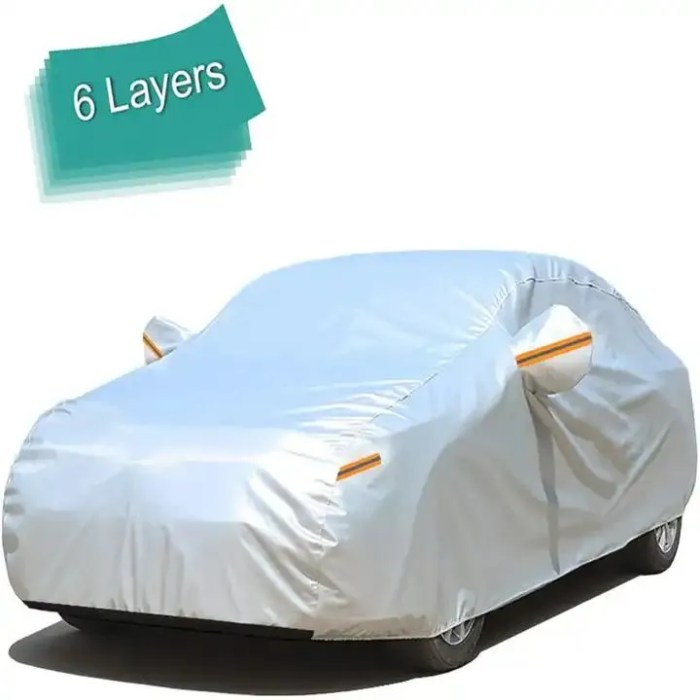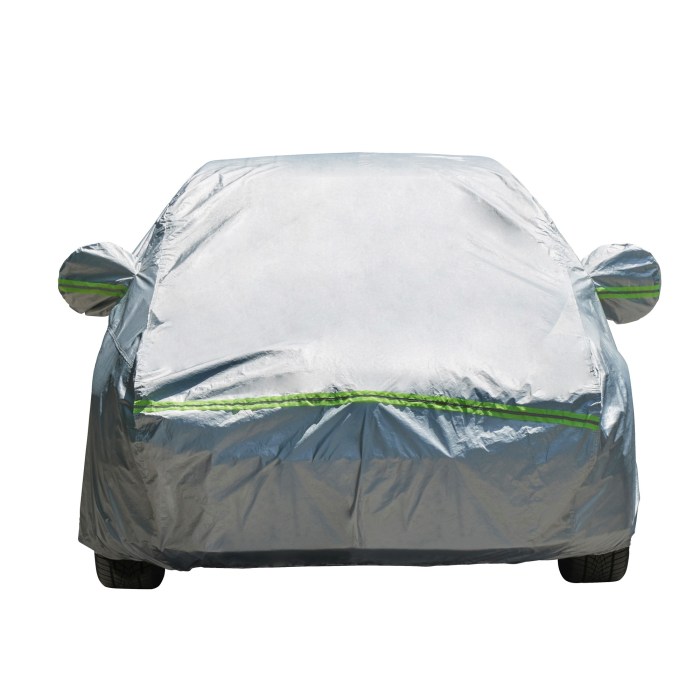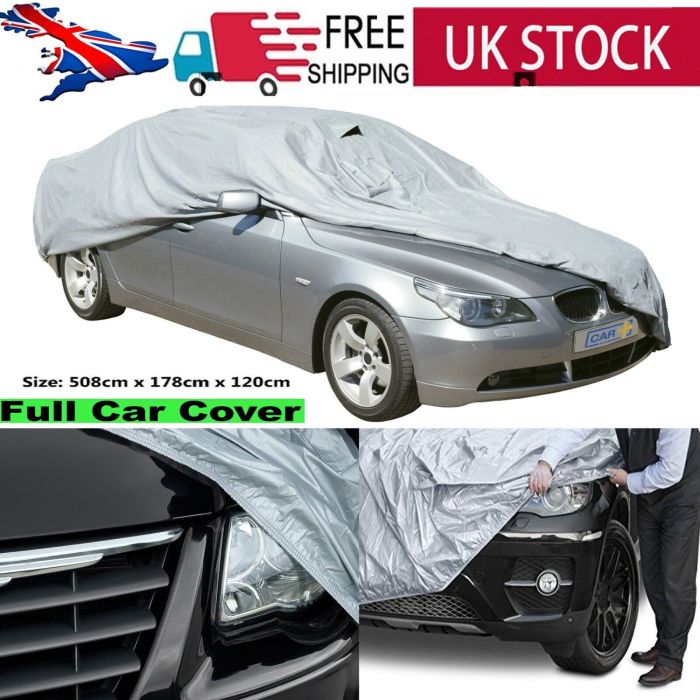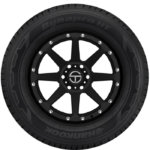Waterproof car covers for outdoor parking? Yeah, they’re way more than just a piece of fabric. Think of them as your car’s superhero cape, protecting it from the elements – hail, sun, snow, you name it. We’re diving deep into the world of waterproof car covers, exploring different materials, features, and how to pick the perfect one for your ride.
Get ready to become a car cover expert!
From basic nylon to high-tech polyester, the options are endless. We’ll break down the pros and cons of each material, helping you decide which offers the best balance of protection and price. We’ll also cover essential features like UV protection and secure fastening, and walk you through choosing the right size and installing it like a pro. By the end, you’ll be confident in your ability to shield your car from the harsh realities of outdoor parking.
Types of Waterproof Car Covers

Protecting your car from the elements is crucial, especially if you park outdoors. A waterproof car cover is a great investment, but choosing the right one depends on understanding the different materials available and their respective pros and cons. This section will explore the various types of waterproof car covers and help you determine which best suits your needs and budget.
Waterproof Car Cover Materials
Several materials are commonly used in the construction of waterproof car covers, each offering a unique blend of advantages and disadvantages. The choice often comes down to balancing protection, durability, and cost.
| Material | Advantages | Disadvantages | Price Range |
|---|---|---|---|
| Polyester | Lightweight, breathable, relatively inexpensive, resists tearing and stretching. Offers good UV protection. | May not be as durable as other materials, can be less water-resistant than nylon or PVC, may not offer optimal protection in extreme weather. | $30 – $150 |
| Nylon | Strong, durable, water-resistant, lightweight, resists tearing and stretching, offers good UV protection. | Can be more expensive than polyester, less breathable than polyester, may not be completely waterproof without a coating. | $50 – $250 |
| PVC | Completely waterproof, durable, inexpensive for basic models, relatively easy to clean. | Heavy, not breathable, can be stiff and difficult to handle, can crack or become brittle over time, may not offer good UV protection without additional treatment. Less aesthetically pleasing than other materials. | $40 – $180 |
Durability and Longevity of Waterproof Car Cover Materials
The longevity of a waterproof car cover depends heavily on the material used, the quality of construction, and how well it’s cared for. Polyester covers, while less expensive, might only last a couple of years with regular outdoor use, especially in harsh climates. Nylon covers, due to their superior strength, often offer a longer lifespan, potentially lasting three to five years or more under similar conditions.
PVC covers can also be quite durable, but their susceptibility to cracking and brittleness means their lifespan can be unpredictable, depending on temperature fluctuations and UV exposure. Proper storage and care significantly extend the life of any car cover regardless of material. For example, a high-quality nylon cover properly stored indoors during harsh weather will outlast a poorly cared-for PVC cover left outside year-round.
Features of Waterproof Car Covers
Choosing the right waterproof car cover involves understanding its key features. A cover’s effectiveness and longevity depend heavily on the quality and design of these features, ensuring your vehicle stays protected from the elements. Factors like material, construction, and added features all play a crucial role in determining the overall performance of the cover.Protecting your car from the elements requires a cover that goes beyond simple waterproofing.
The right cover will provide a multi-layered defense against various environmental threats. Let’s explore the most critical features to consider when investing in a waterproof car cover for outdoor use.
UV Protection
UV rays from the sun can cause significant damage to your car’s paint, fading its color and leading to cracking over time. A good waterproof car cover should offer UV protection, typically through the use of specialized materials that reflect or absorb these harmful rays. This protection extends the life of your car’s paint job, maintaining its value and appearance.
Look for covers that explicitly mention their UV protection capabilities and the level of protection they offer, often measured by a UPF (Ultraviolet Protection Factor) rating, similar to sunscreen. A higher UPF rating indicates better protection.
So, you’re parking your ride outside and need a killer waterproof car cover, right? Finding the best one can be a total hassle, but managing your insurance is also key. Check out what people are saying about the Geico DriveEasy app reviews 2025 to see if it helps with claims if something does happen to your car.
Then, once you’ve got your insurance sorted, you can totally focus on finding that perfect waterproof cover to keep your baby safe from the elements.
Breathability
While waterproofing is crucial, a completely airtight cover can trap moisture, leading to mildew and mold growth under the cover. Breathable car covers allow for air circulation, preventing the buildup of moisture and promoting a dry environment for your vehicle. This breathability is usually achieved through the use of specialized fabrics with micro-pores that allow air to pass through while still repelling water.
The balance between waterproofing and breathability is key; a highly breathable cover might not be entirely waterproof, and a completely waterproof cover might lack breathability.
Wind Resistance
Strong winds can lift and damage a poorly designed car cover. Secure fastening mechanisms and a snug fit are essential to prevent wind from getting underneath the cover. Features like elastic hems, straps, and buckles help to secure the cover firmly to the car, minimizing the risk of it being blown away or flapping in the wind, which can cause abrasion against the paint.
Secure Fastening Mechanisms
The fastening system is a critical component of a car cover’s effectiveness. A poorly designed system can render even the most durable cover useless. Look for covers with multiple secure fastening points, such as straps, buckles, and elastic hems. These features help to keep the cover in place, even in strong winds, preventing it from blowing away or shifting, which could expose your car to the elements.
Some covers also include a built-in theft deterrent system to provide an additional layer of security.
Five Key Features and Their Benefits for Outdoor Car Protection
Choosing a car cover is a significant investment in protecting your vehicle. Here are five essential features and their benefits:
- Waterproof Material: Prevents water damage from rain, snow, and other moisture, protecting the paint and interior from rust and mildew.
- UV Protection: Shields the paint from harmful UV rays, preventing fading, cracking, and degradation, preserving the car’s value and appearance.
- Breathable Fabric: Allows for air circulation, preventing moisture buildup and the growth of mold or mildew underneath the cover.
- Secure Fastening System: Keeps the cover firmly in place, even in windy conditions, preventing damage from flapping or blowing away.
- Durable Construction: Ensures the cover can withstand harsh weather conditions and regular use without tearing or ripping, extending its lifespan.
Choosing the Right Waterproof Car Cover: Waterproof Car Covers For Outdoor Parking

Selecting the perfect waterproof car cover involves more than just picking the first one you see. A proper fit ensures optimal protection from the elements and prevents the cover from flapping in the wind or becoming dislodged. Consider your car’s dimensions, its type, and your budget to make an informed decision. This guide will walk you through the process.
Car Size and Type Considerations
Different vehicles require different cover sizes and designs. Sedans generally need covers designed for their sleek profiles, while SUVs and trucks demand larger covers that accommodate their height and length. Covers specifically designed for convertibles will often have extra features like reinforced stitching to better withstand the strain of the fabric when the car is stored with the top down.
For example, a compact sedan will require a smaller cover than a full-size pickup truck. Failing to consider these differences can lead to a poorly fitting cover that doesn’t provide adequate protection or could even damage your vehicle’s paint. Always check the manufacturer’s specifications for exact measurements to match your car’s dimensions.
Decision-Making Flowchart for Choosing a Waterproof Car Cover, Waterproof car covers for outdoor parking
The following flowchart will help guide your decision-making process based on your priorities and budget.
Start
|
Is your budget under $50?
|
/ \
/ \
Yes No
| |
Choose a basic cover |
| |
Consider material |
| |
| Is your car a standard sedan?
| |
| / \
| / \
| Yes No
| | |
Choose a standard sedan cover | Choose a cover for your car type (SUV, truck, convertible, etc.)
| |
| |
| Consider additional features (mirrors, antenna)
| |
| |
| Choose a cover based on size and features
| |
| |
\-----------/
|
End
Note: This is a simplified flowchart.
More complex decision points, such as specific material preferences or desired features (e.g., UV protection, breathability), could be added.
Accurate Car Measurement Tips
Accurately measuring your car is crucial for a proper fit. Use a measuring tape and follow these steps:
- Measure the length of your car from the front bumper to the rear bumper.
- Measure the width of your car at its widest point.
- Measure the height of your car from the ground to the highest point (usually the roof).
- Note any additional features, like a rear spoiler or side mirrors, that might affect the cover’s fit. Add extra inches to your measurements to accommodate these features.
- Compare your measurements to the manufacturer’s size chart before purchasing.
Remember, it’s always better to choose a cover that’s slightly larger than necessary to ensure a comfortable fit and prevent the cover from being too tight, which could potentially damage your vehicle’s paint.
Installation and Maintenance
Proper installation and regular maintenance are key to extending the life of your waterproof car cover and ensuring optimal protection for your vehicle. Neglecting these steps can lead to premature wear and tear, reduced effectiveness, and even damage to your car’s paint.
Taking care of your car cover is as important as choosing the right one. Following these simple steps will keep your cover in top condition and your car protected from the elements.
Installing a Waterproof Car Cover
Correctly installing your car cover is crucial for its effectiveness and longevity. Improper installation can lead to flapping in the wind, potential damage to the cover, and inadequate protection for your vehicle. Here’s a step-by-step guide:
- Clean your car thoroughly. Remove any dirt, debris, or bird droppings before installing the cover. This prevents scratching the paint and trapping abrasive particles under the cover.
- Start at the front of the vehicle. Gently drape the cover over the windshield and hood, ensuring it’s centered.
- Work your way back, smoothing out any wrinkles or air pockets as you go. Avoid pulling or stretching the material excessively.
- Secure the cover using any straps, buckles, or elastic hems provided. Make sure it’s snug but not overly tight, to avoid stretching or tearing the fabric.
- Tuck in any loose edges or flaps. Pay close attention to the areas around the mirrors and bumpers.
Cleaning and Storing a Waterproof Car Cover
Regular cleaning and proper storage are essential for maintaining the waterproofness and overall condition of your car cover. This helps prevent mildew, mold, and deterioration of the fabric.
- Inspect the cover regularly for any signs of dirt, debris, or damage. Address minor issues promptly to prevent them from worsening.
- To clean, use a mild detergent and lukewarm water. Avoid harsh chemicals or abrasive cleaners that can damage the waterproof coating.
- Gently scrub the cover with a soft brush or sponge, rinsing thoroughly afterward.
- Allow the cover to air dry completely in a shaded area before storing. Avoid direct sunlight, which can fade the color and weaken the fabric.
- Store the cover in a cool, dry place away from direct sunlight and moisture. A breathable storage bag is ideal.
Addressing Common Issues
Even with proper care, you may encounter some common problems with your waterproof car cover. Knowing how to handle these situations will help prolong its lifespan and protect your vehicle.
- Trapped Moisture: If moisture becomes trapped under the cover, remove the cover immediately and allow the car to air dry thoroughly. This prevents mildew and rust. Regularly checking for trapped moisture is recommended, especially after periods of rain or high humidity.
- Cover Damage: Minor tears or rips can be repaired with a waterproof patching kit. For more extensive damage, it’s best to contact the manufacturer or a professional for repair or replacement. Regular inspection can prevent small tears from becoming larger problems.
Protection Offered by Waterproof Car Covers

Protecting your car from the elements is crucial, especially if you park outdoors. A waterproof car cover acts as a shield, significantly extending the lifespan of your vehicle’s paint and interior. The level of protection offered varies depending on the cover’s material and design, but generally, these covers offer substantial defense against a range of environmental hazards.A waterproof car cover provides a significant barrier against various forms of environmental damage.
The most obvious benefit is protection from precipitation – rain, snow, and sleet – preventing water damage to the paint, upholstery, and electrical systems. Beyond water, these covers also safeguard against the harsh UV rays of the sun, which can cause fading and cracking of the paint and interior materials. Furthermore, they act as a barrier against dust, dirt, tree sap, bird droppings, and other airborne pollutants that can accumulate and damage your car’s finish.
Even things like scratches from branches or minor impacts are less likely to occur with a protective cover.
So, you’re parking your ride outside and need a killer waterproof car cover to keep it safe? That’s smart! Before you buy, though, make sure you’ve crunched the numbers using this awesome car loan calculator with taxes and fees to see how much that new cover (and your car!) will really cost. Then you can pick the perfect cover without stressing about your budget.
Protection Against Water Damage
Waterproof car covers, as their name suggests, effectively repel water. The material is typically treated to be highly water-resistant, preventing moisture from penetrating and causing rust, mold, or mildew. Different materials, such as nylon or polyester, offer varying degrees of water resistance, with some higher-end covers boasting near-total impermeability. A high-quality cover will also feature seams sealed to prevent water leakage.
This is especially important in areas with heavy rainfall or snowfall. Consider a cover with a water-resistant backing for superior protection against even the most persistent moisture.
Protection Against UV Radiation
The sun’s UV rays are a major culprit in car paint degradation. Prolonged exposure can lead to fading, cracking, and even paint peeling. Many waterproof car covers incorporate UV-resistant materials to block a significant portion of these harmful rays. The effectiveness of UV protection varies depending on the cover’s material and its density. Covers with thicker, denser fabrics, often those using multiple layers or specialized coatings, offer superior protection against UV damage.
Think of it as sunscreen for your car; a quality cover is like applying high SPF sunscreen every day.
Protection Against Airborne Pollutants
Dust, dirt, pollen, bird droppings, and industrial pollutants can all contribute to the deterioration of your car’s exterior. A waterproof car cover acts as a physical barrier, preventing these contaminants from settling on the paint and causing damage. This is especially beneficial in urban areas or regions with high levels of air pollution. The smoother, more tightly woven the fabric, the less likely pollutants are to penetrate or embed themselves in the material.
Regular cleaning of the cover itself will also help to prevent the accumulation of these contaminants and maintain the protection it provides.
Illustrative Example of Protected Car
Imagine a sleek, silver sedan parked under a tree in a bustling city. A high-quality, custom-fit waterproof car cover drapes over the vehicle, completely enveloping it. The cover’s deep blue fabric protects the car’s paint from the sun’s harsh UV rays, preventing fading and discoloration. The silver paint remains gleaming and free from dust, bird droppings, and tree sap, thanks to the cover’s effective barrier against airborne pollutants.
Even a sudden downpour wouldn’t affect the car, as the water simply beads up and rolls off the waterproof material, leaving the car’s interior and exterior dry and safe. The cover fits snugly, shielding all surfaces, including the windshield, hood, mirrors, and tires, offering comprehensive protection from the elements.
Price and Value Considerations
Choosing a waterproof car cover involves more than just picking the first one you see; the price significantly impacts the quality, features, and ultimately, the protection your car receives. Understanding the price range and what you get for your money is crucial for making an informed decision. Different factors influence the cost, leading to a wide spectrum of options available.The price of waterproof car covers generally ranges from around $30 for basic models to over $300 for premium, highly specialized covers.
Several factors contribute to this variation. Material quality plays a significant role; thicker, more durable materials like multiple layers of high-density polyethylene or ripstop nylon command higher prices. Added features such as UV protection, soft inner linings to prevent scratches, and custom-fit designs also increase the cost. Brand reputation and warranty offerings also impact pricing. Established brands often charge more, reflecting their commitment to quality and customer service.
Price Ranges and Corresponding Features
The value proposition of a car cover is strongly tied to its price. Budget-friendly covers ($30-$80) typically offer basic water resistance and some protection from dust and debris. However, they may lack features like UV protection and might be made of thinner, less durable materials. Mid-range covers ($80-$150) generally offer improved water resistance, UV protection, and a more robust construction.
They often include features like elastic hems and mirror pockets. High-end covers ($150-$300+) are usually custom-fit, made from exceptionally durable materials, and incorporate advanced features like breathable layers to prevent moisture buildup and soft inner linings to protect the paint. These covers are designed for long-term protection and often come with extended warranties.
Comparison of Waterproof Car Cover Value
The following table summarizes the price, key features, and overall value assessment of different hypothetical car cover brands, reflecting the general market trends:
| Brand | Price (USD) | Key Features | Value Assessment |
|---|---|---|---|
| CoverGuard Basic | $40 | Water-resistant, basic material, elastic hem | Good value for basic protection, limited durability. |
| AutoShield Pro | $100 | Water-resistant, UV protection, breathable material, mirror pockets | Excellent value for the features offered, good balance of price and quality. |
| PremiumCover Elite | $250 | Custom fit, heavy-duty material, UV protection, breathable, soft inner lining, extended warranty | High value for superior protection and durability, ideal for long-term use and high-value vehicles. |
Closing Summary
So, there you have it – your complete guide to conquering outdoor car parking with waterproof car covers. From choosing the right material and features to mastering the installation and maintenance, we’ve covered all the bases. Remember, a little preventative care goes a long way in keeping your car looking its best. Now go forth and protect your precious ride!









